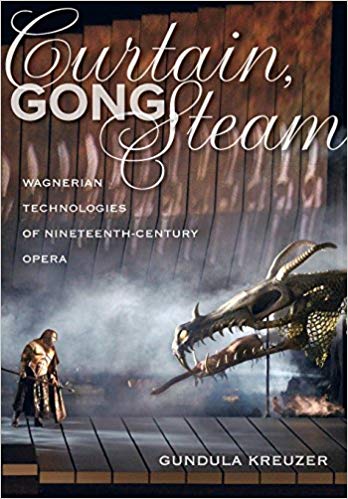Curtain, Gong, Steam: Wagnerian Technologies of Nineteenth-Century Opera.
Gundula Kreuzer. Berkeley: University of California Press, 2018. 368 pp. 12 musical examples and 26 b/w images. ISBN: 9780520279681. $70.00.

Gundula Kreuzer’s monograph is, in her own words, an examination of “the relationship between opera and technology from the dual yet entwined perspectives of production and preservation,” (p. 3) with a focus on Richard Wagner. Kreuzer’s three titular technologies share, she says, a “potential to veil… their own mechanical nature” (p. 21) and a certain ephemerality. Even as Wagner, in particular, fixed these effects in the text (whether score, staging manual, or performance tradition), they proved vulnerable to the passage of time and—Kreuzer’s most intriguing idea—to failure. Technology’s promise to conceal is bound up with the possibility that its illusion will be broken—either because its success attracts too much attention or because some mishap on stage (the swan is late, a curtain is mistimed, etc.) exposes the mechanical basis of the Gesamtkunstwerk’s magic.
Kreuzer’s introduction grounds her study in recent critical approaches to media and technology. This has certainly been a fertile ground for musicologists in recent years, and Kreuzer’s book can be located in the same general territory as studies by scholars such as Richard Leppert, Arman Schwartz, Alessandra Campana, and David Trippett. Notably Kreuzer’s focus skews earlier than most of these, and while Wagner has a central role, she discusses a large variety of musical works, primarily from Germany and France. Kreuzer’s book is densely written and will be of interest primarily to those in musicology, theater studies, and media studies.
Kreuzer’s study combines meticulous historical research and critical analysis, which makes for innovative, exciting work. The study is framed by an initial chapter on “Wagner’s Venusberg” and an epilogue, “Wagnerian Failure,” with longer chapters devoted to each of the three technologies in the middle. Chapter 1 is the book’s most sustained examination of one particular work. Arguing that Tannhäuser “enacts [a] fight between opera and drama, between inherited forms and fresh approaches” (p. 27), Kreuzer considers the material technologies used in staging the innovative space of the Venusberg. She equates the composer not with Tannhäuser, but with Venus, stage director and master of illusions in her own grotto.
Kreuzer’s central three chapters share a common structure: before Wagner, Wagner, and after Wagner. In Chapter 2, “Curtain,” she examines the early history of the curtain, which she argues began to move “between total visibility and (almost) complete concealment, static architecture and dynamic performance, stage and auditorium” (p. 58) over the course of the late eighteenth and early nineteenth centuries. In a fascinatingly material history, she surveys Grétry, Weber, and Meyerbeer, arguing that curtains served as a “mediating agent” between opera’s varied media (p. 80).
Chapter 3, “Gong,” considers a sound which stood on the boundary between noise and music, stage and pit, East and West. The gong’s exotic, then magic, then also mechanical sound would seem to exemplify Wagner’s notorious “effects without causes,” always in danger of reminding the audience of China, or dinner. Finally, Kreuzer takes a brief tour through later gongs up to glam rock, the Gong Show, and Stockhausen. Kreuzer’s gongs take on so many meanings in so many brief examples that in this chapter her work seems to approach what Nicholas Mathew and Mary Ann Smart have dubbed “quirk historicism,” in which whimsical found objects can signify any number of things depending on the scholar’s purpose (“Elephants in the Music Room,” Representations 132, no. 1 (Fall 2015), 61-78).
Fortunately, most of Kreuzer’s study is more directed. Chapter 4, “Steam,” is the book’s longest. Fog, Kreuzer shows, was considered emblematic of Wagner and his music: nebulous melodies, evasive harmonic progressions, remote plots; but this was because in the Ring Cycle Wagner used steam extensively onstage with no real precedent. Steam and fog, Kreuzer argues, are associated with a number of different thing—the Rhine, Nibelheim, sunrises, fire—and serves to “evoke the haze of the unknown, distant past” (p. 167). But at the same time it could serve the more practical purpose of concealing scene changes, transformations, and other mechanical vagaries of production, even as it represented “nothing but itself” (p. 183).
In her epilogue, Kreuzer considers the post-Wagnerian legacies of these technologies and their continuing fallibility in more detail, including more recent attempts to integrate humans and machines onstage. “New technologies,” she argues,” have been central to the realization of nineteenth-century composers’ ever more intricate imaginings of multimedia representation” but the practice of such technologies was “unstable and disintegrated quickly” (p. 218). As in many chapters, she describes Wagner’s efforts to fix a production style for his work, particularly in association with Angelo Neumann’s early touring Ring production. (The structure of Kreuzer’s book requires her to introduce Neumann in nearly every chapter, and her analyses of his work are scattered throughout the book.) In what may be an interesting analysis for many readers, Kreuzer then considers Robert Lepage’s widely disseminated Ring Cycle at the Metropolitan Opera, arguing that the “most authentic aspect of Lepage’s production is the overall failure of its illusionist agenda” due to technical glitches (p. 231).
Kreuzer’s study is an energetic and often fascinating look at aspects of theatrical illusion too often taken for granted. Kreuzer’s writing tends to the wordy (I would have preferred fewer uses of “foggy” and “steamy” in Chapter 4), and the book feels somewhat conceptually overstuffed, but even when she seems to be wandering afield Kreuzer returns to her central themes in eminently convincing fashion. Curtain, Gong, Steam’s richness also makes it valuable as a starting point for further studies. For example, I frequently thought of Achim Freyer’s fascinating 2010 Ring Cycle in Los Angeles, whose Götterdämmerung ended with the dismantling of its own theatrical apparatus, equating the gods themselves with a kind of stage illusion. Kreuzer suggests, however, that there will be no such end to the creative, glitchy, and fascinating use of technology onstage.
